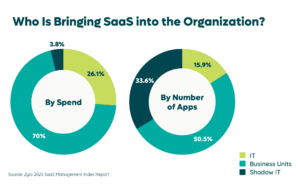
Zoom License Cost 2026: Which Plan Offers the Best Value for Your…
Table of Contents ToggleEliminate Duplicate or Redundant SaaS ApplicationsProactively Manage SaaS...
Back
Back
Search for Keywords...
Blog

Table of Contents
We interact with a lot of teams across the spectrum of technology acquisition and management here at Zylo. From procurement, sourcing, and vendor management teams to CIOs, enterprise architects, and software asset managers, there’s a wide range of disciplines interested in reducing the potential risks from explosive SaaS growth and optimizing the value of their SaaS portfolio investment. But how do you realize hard SaaS cost savings for your organization?
Here are four ways to leverage cost savings and improve the value of your SaaS investments.
SaaS applications are incredibly easy to purchase and deploy – but also easy to forget. Couple that with the fact that SaaS ownership is frequently in the hands of business units, teams or employees – and not centrally managed by IT. There’s also thepotential for duplication and redundancy across the organization. According to Zylo’s SaaS Management Index, 74% of all SaaS spending is from lines of business and individual employees, not IT.

When Zylo initially works with new customers, we find that they often underestimate their application inventory by 1.7X and spend by 3X. Meaning they think they have 150 applications and spend $3M, but in reality they have 255 and spend $9M. Much of this inventory is comprised of duplicate applications (the same application with multiple subscriptions across the organization), as well those with overlapping functionality (redundant applications, apps that accomplish the same function). Cutting this SaaS application “fat” and eliminating applications frequently leads to significant cost savings for enterprises.
To identify SaaS these cost savings opportunities, technology managers must engage in a discovery process to identify what applications are present across the organization. A SaaS Management platform can speed this process.
After every application has been identified and placed in a central system of record, value-focused teams can begin the collaborative process of eliminating applications that are no longer needed, consolidating applications to reduce overall spend (more on this later), and standardizing applications for specific business functions.
Mismanaged renewals are another contributing factor to the proliferation of SaaS – and often result in money being left on the table during negotiations. Automatic renewals have the upsides of continuity and convenience, but missing a renewal date effectively locks the business into a new billing cycle — whether the application is needed or not. Preventing an unneeded renewal presents a significant opportunity to recoup value. On average, Zylo customers experience nearly one SaaS renewal every day.

To avoid the cost of missed renewals, we recommend building a database of all of your SaaS applications and building a proactive renewal calendar. Just as each application should have its functional category, owner, cost center, and value listed in the database, its renewal notification period and renewal date should also be included.
By planning dates in advance and prioritizing application renewal decision-making by value and impact to the organization, technology managers can ensure that automatic renewals are proactive, not reactive, and that value is preserved.
How many SaaS licenses in your organization go unused or underused? Measuring your SaaS tech stack with a focus on utilization, then managing applications based on that data is another way to reap more value. Our data shows that the average organization is only utilizing 47% of their provisioned licenses, meaning 53% of licenses are wasted, unused and ripe for optimization. And when you consider that the average organization spends $49M on SaaS annually, the potential savings is huge.

Imagine the following scenario: Your organization has a large enterprise-wide SaaS application like a CRM. The tool’s contract affords a finite number of seats to deploy to users. How can technology managers ensure that provisioned users are using their seats in a way that maximizes their value?
For many organizations, this is where a SaaS Management tool comes in handy, especially if it features direct integrations into multiple applications.
By measuring usage activity, teams responsible for optimizing SaaS can deploy workflows to identify underutilized seats and, if necessary, reprovision them to users who will use them more actively. If there is not a group of users who can make use of unused seats, the contract can be right-sized at renewal.
The converse of not enough users for an application is finding that multiple users across the business all have separate subscriptions to the same application. A proven way to recover value from existing SaaS spend is to consolidate these disparate instances under a single enterprise license agreement (ELA).
Not only are SaaS vendors more likely to provide a better overall per-user rate with an ELA, but it provides additional options such as multi-year discounts, caps on price increases, and clauses specific to security and governance, further protecting the organization.
To learn more about Zylo’s recommendations for SaaS Management and value optimization, and about Zylo’s SaaS management solution itself, contact us to schedule a demo.

Table of Contents ToggleEliminate Duplicate or Redundant SaaS ApplicationsProactively Manage SaaS...

Table of Contents ToggleEliminate Duplicate or Redundant SaaS ApplicationsProactively Manage SaaS...

Table of Contents ToggleKey Themes That Shaped SaaS Management in 20251....

Table of Contents ToggleEliminate Duplicate or Redundant SaaS ApplicationsProactively Manage SaaS...
| Cookie | Duration | Description |
|---|---|---|
| cookielawinfo-checkbox-analytics | 11 months | This cookie is set by GDPR Cookie Consent plugin. The cookie is used to store the user consent for the cookies in the category "Analytics". |
| cookielawinfo-checkbox-functional | 11 months | The cookie is set by GDPR cookie consent to record the user consent for the cookies in the category "Functional". |
| cookielawinfo-checkbox-necessary | 11 months | This cookie is set by GDPR Cookie Consent plugin. The cookies is used to store the user consent for the cookies in the category "Necessary". |
| cookielawinfo-checkbox-others | 11 months | This cookie is set by GDPR Cookie Consent plugin. The cookie is used to store the user consent for the cookies in the category "Other. |
| cookielawinfo-checkbox-performance | 11 months | This cookie is set by GDPR Cookie Consent plugin. The cookie is used to store the user consent for the cookies in the category "Performance". |
| viewed_cookie_policy | 11 months | The cookie is set by the GDPR Cookie Consent plugin and is used to store whether or not user has consented to the use of cookies. It does not store any personal data. |
